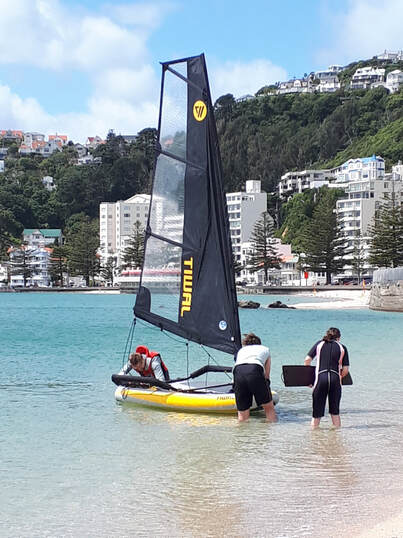|
Learn to Sail Part 2. Have you have decided to give sailing a go? Firstly, you need a little understanding of the wind, the sail and the parts of the boat which are underwater. You need to know where the wind is coming from. The first reason you need to know, is so you can turn the boat into the wind when you are setting up the boat.. or when you are launching the boat into the water. If you turn the boat away from the wind the sail will fill with wind and the boat will try and jump around and make it very hard to push into the water without it falling over! Now lets get onto the water. Your sail is your engine - so looking at your sail is important (as well as looking where you are going!). When you are on the water you need to know where the wind is coming from because when you point the boat into the wind you won’t move anywhere - the sail will just flap. Wind direction awareness is also needed so you can stop the boat on the water whenever you like - just turn the boat into the wind and let the sail flap. If you want to move forward you need a curve in the sail. This creates power. You need to point the front of the boat away from the wind and pull the sail in just enough so there is a nice curve (and no flapping). Perhaps you have turned away so far from the wind that the wind is now directly behind you? Now you need to let the sail out enough to catch the wind. A good rhyme to remember is ‘if in doubt, let it out’ (the sail, I mean). But if it flaps, pull it in! So where do you sit? You and the wind will work together to balance the boat. If the boat is tipping to one side you need to move to balance the boat and make it flat again. This means you will usually sit opposite the sail - to balance the wind pushing against the sail on the other side. When the sail changes sides so will you (this is called a tack or gybe). You also need to know what is happening under the boat (underwater) that is helping you move and turn. Your rudder turns the boat - but this will only work if you have water flowing over it - you need to be moving to turn the boat. Your centreboard (the board in the centre of the boat) helps you sail towards the wind. So it is important to have this all the way down into the water - otherwise you will slip sideways. So, now you know where the wind is coming from, that you need to look at and adjust your sail, and you know what is helping the boat move and turn underwater. Stay tuned for more tips! #tiwal #dream_big_pack_small
0 Comments
Leave a Reply. |
Melinda HenshawI am a New Zealand sailor who learned to sail in the beautiful Malborough Sounds and then went onto represent NZ at the 2000 Olympics. Archives
December 2023
Categories |



 RSS Feed
RSS Feed
